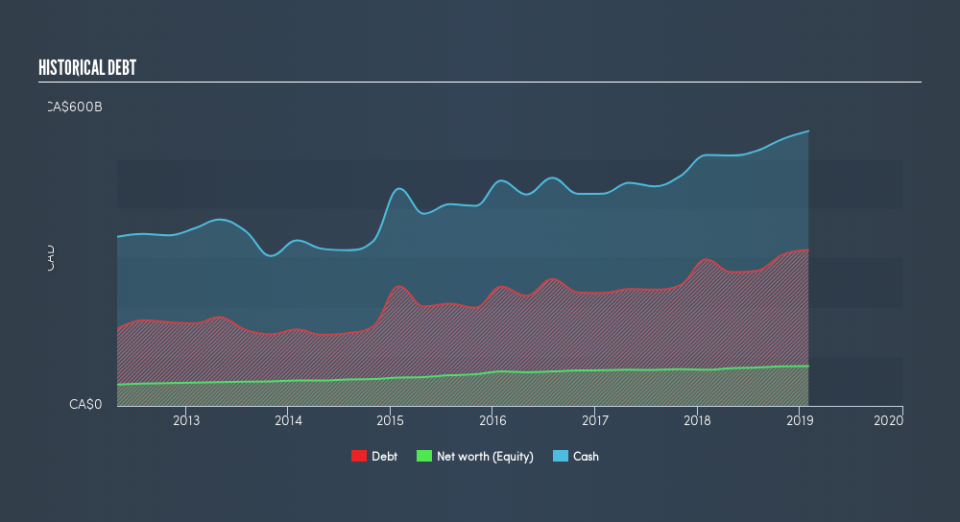Risk Factors To Consider Before Investing In Royal Bank of Canada (TSE:RY)

Want to participate in a research study? Help shape the future of investing tools and earn a $60 gift card!
Post-GFC recovery has strengthened economic growth and credit quality, benefiting large banks such as Royal Bank of Canada (TSE:RY), with a market capitalisation of CA$148b. A borrower’s demand for, and ability to repay, loans is driven by economic growth which directly impacts the level of risk Royal Bank of Canada takes on. With stricter regulations as a result of the GFC, banks are more conservative in their lending practices, leading to more prudent levels of risky assets on the balance sheet. The level of risky assets a bank holds on its accounts affects the attractiveness of the company as an investment. So today we will focus on three important metrics that are insightful proxies for risk.
View our latest analysis for Royal Bank of Canada
How Much Risk Is Too Much?
Royal Bank of Canada may be taking on too many risky loans if it is over-exposed to bad debt. Generally, loans that are “bad” and cannot be recovered by the bank should make up less than 3% of its total loans. Bad debt is written off when loans are not repaid. This is classified as an expense which directly impacts Royal Bank of Canada’s bottom line. Since bad loans only make up an insignificant 0.47% of its total assets, the bank may have very strict risk management - or perhaps the risks in its portfolio have not eventuated yet.
How Good Is Royal Bank of Canada At Forecasting Its Risks?
Royal Bank of Canada’s ability to forecast and provision for its bad loans indicates it has a good understanding of the level of risk it is taking on. We generally prefer to see that a provisions covers close to 100% of what it actually writes off, as this could imply a sensible and conservative approach towards bad loans. Given its high non-performing loan allowance to non-performing loan ratio of 110.03% Royal Bank of Canada has cautiously over-provisioned 10.03% above its current level of non-performing loans. This could indicate a prudent forecasting methodology, or indicate that further bad loans are expected.
Is There Enough Safe Form Of Borrowing?

Royal Bank of Canada profits from lending out its various forms of borrowings and charging interest rates. Deposits from customers tend to carry the lowest risk due to the relatively stable interest rate and amount available. As a rule, a bank is considered less risky if it holds a higher level of deposits. Since Royal Bank of Canada’s total deposit to total liabilities is within the sensible margin at 66% compared to other banks' level of 50%, it shows a prudent level of the bank's safer form of borrowing and an appropriate level of risk.
Next Steps:
How will RY’s recent acquisition impact the business going forward? Should you be concerned about the future of RY and the sustainability of its financial health? I’ve bookmarked RY’s company page on Simply Wall St to stay informed with changes in outlook and valuation. This is also the source of data for this article. The three main sections I’d recommend you check out are:
Future Outlook: What are well-informed industry analysts predicting for RY’s future growth? Take a look at our free research report of analyst consensus for RY’s outlook.
Valuation: What is RY worth today? Has the future growth potential already been factored into the price? The intrinsic value infographic in our free research report helps visualize whether RY is currently mispriced by the market.
Other High-Performing Stocks: Are there other stocks that provide better prospects with proven track records? Explore our free list of these great stocks here.
We aim to bring you long-term focused research analysis driven by fundamental data. Note that our analysis may not factor in the latest price-sensitive company announcements or qualitative material.
If you spot an error that warrants correction, please contact the editor at editorial-team@simplywallst.com. This article by Simply Wall St is general in nature. It does not constitute a recommendation to buy or sell any stock, and does not take account of your objectives, or your financial situation. Simply Wall St has no position in the stocks mentioned. Thank you for reading.

 Yahoo Finance
Yahoo Finance 
